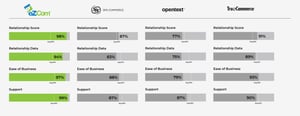What’s in store? Our 2019 Retail Predictions are here.
After another year of historic change — once-venerated stores shuttering, online channels emerging, supply chains growing more sophisticated — trying to figure out what will shape retail and order management in 2019 isn’t easy. We definitely wouldn't want to bet that all of these 2019 Retail Predictions will pan out.
But predictions can be useful. They can make us think about what we need to do to stay nimble and flexible. They can prompt us to try something new or revisit an old concept. With that in mind, here are our Top Ten 2019 Retail Predictions.
1) Generating more sales will require even less friction.
The rumored rapid expansion of the Amazon Go concept has been repeated enough that it doesn’t even really count as a rumor anymore. Plans to open thousands of these stores will take it from a concept to a fixture of the retail landscape.
Why will Amazon Go continue to grow? Consumers, especially millennials, want as few barriers as possible when they make purchases. If you thought one-click ordering was the peak, get ready for more stores adopting the Amazon Go model — walk in, load up your cart or basket, walk out. Your account is automatically charged — no line to wait in as you watch a cashier struggle to get a scanner to read a label.
2) Amazon will become even more dominant. (Yes, we‘re aware we’re not exactly going out on a limb on this one.)
Remember when Amazon only sold books? We do, but only barely. It doesn’t even count as prognostication to say this company will continue to grow in 2019. But indulge us — we need at least one bullet-proof prediction on this list.
3) Brick-and-mortar retail will continue to surprise.
Wait, what’s that? Brick-and-mortar isn’t dead? Nope. Far from it. Today, we see brands that launched as online sellers — Warby Parker, Iron & Resin, Bonobos, Buck Mason — continuing to expand and grow their presence beyond the web. While many are using different models — stores with less square footage, pop-ups, stores within stores — smart brands know that having a place where people can see and touch their products still matters. Not only will we see more online brands establish brick-and-mortar locations, we’ll see smart, traditional retailers enjoy growth by establishing distinct identities and continuing to serve up a unique merchandise mix.
4) More online brands will build offline presence.
With concepts like pop-up stores and thoughtfully curated merchandise mixes, more online brands will establish physical locations. And for good reason. Today’s consumers have a wider range of options than ever before — the product they want can be found anywhere. Creating experiences builds brand loyalty, a currency that is harder than ever to accumulate. What’s more, stores like Sephora have made retail more experiential than ever before and raised the bar for the entire industry.
5) When it comes to buzzwords, "omnichannel" will be old. Get used to "omnipresence."
Buying on Instagram? Shopping on Facebook, Twitter, or Snap? Yes, we think it won’t be long before shopping will happen, well, everywhere. But just like finding the right partner in traditional retail, you’ll want to be sure you’re using the proper channels for your brand — Gen-Z is barely on Facebook but Baby Boomers can barely get through a day without it.
But social media is just one example. In 2019, consumers may discover your product just about, well, anywhere. That’s why omnichannel will become dated — stop lobbing that word out and switch to omnipresence. In other words, there’s now almost nothing that can’t be considered a retail environment, whether it’s social media or a weekend popup at an urban marketplace.
6) Retailers like Dillard’s and Stein Mart will continue to find ways to succeed.
While so much of the talk in retail has been focused on eCommerce, many regional and niche retailers have found ways to bring in more customers and boost sales. Dillard’s is one example of a retailer that knows its target audience and serves up products that deliver traffic and sales. Stein Mart is another, while sporting goods giant Dick’s Sporting Goods also continues to find ways to draw people to its stores.
7) Small footprint and pop-up stores will help online sellers manage real estate costs.
Not too long ago, everyone was talking about big box. Giant stores with vast selections — and crushing real estate costs. Now that consumers can turn their entire world into a store, a huge warehouse stacked with an almost overwhelming array of goods doesn’t have the same appeal. Part of that is because just about anything for sale in a big box store can be found somewhere else, too. If vast selection was the main draw of big box stores, that advantage no longer exists.
In 2019, we’ll see more online sellers establish a physical, real-world presence with smaller stores and thoughtfully curated merchandise selections. Some will follow the Bonobos model and not even carry actual inventory, instead offering shoppers to try clothes on or sample products before ordering them online and having them shipped to their homes. Finally, more big box retailers will establish smaller versions of their stores to gain footholds in expensive, desirable urban markets.
8) Consumers will be more demanding than ever before.
Driven in large part by the expectations that Amazon has created, shoppers will expect instant gratification and even faster fulfillment. If something isn’t available in a store, they’ll make plans to find it elsewhere. If shipping takes too long, they’ll find another seller that can get the product to them more quickly.
The good news is that more tech than ever will be introduced to the supply chain. That means more speed. What's more, smarter software can produce greater efficiencies. Here at eZCom, for example, we have connectors built into Lingo that our clients use to automatically generate shipping labels and tracking numbers. That’s just one example of features we're constantly adding to save suppliers precious seconds on every order and help them get products out faster.
9) The growth of curated online monthly subscription services will cool.
What? You’ve been rambling on about how the hot trend will be reducing obstacles to purchase? What’s more seamless than an online subscription service?
True enough, a subscription service does make it easier than ever for consumers to buy. After all, after they sign up, they wind up making a purchase every month, whether they remember or not.
So why do we think the growth of these subscription services will slow? For us, it’s about managing the retail experience. When someone shops at a store, for example, it only takes one bad experience or a slightly less-than-perfect purchase to make another visit less likely. The pressure to deliver every month will eventually become too much for subscription services. When one month’s package of products leaves a buyer unsatisfied, or if two months in a row make them say, “Meh,” it’s very likely that becomes a canceled subscription.
10) Retail will remain interesting.
Hey, this one is easy. As stressful as it can be, what other business offers so many opportunities for creativity and new ideas? So we're predicting that 2019 will be like 2018 — never boring and a bit of a crazy party.







